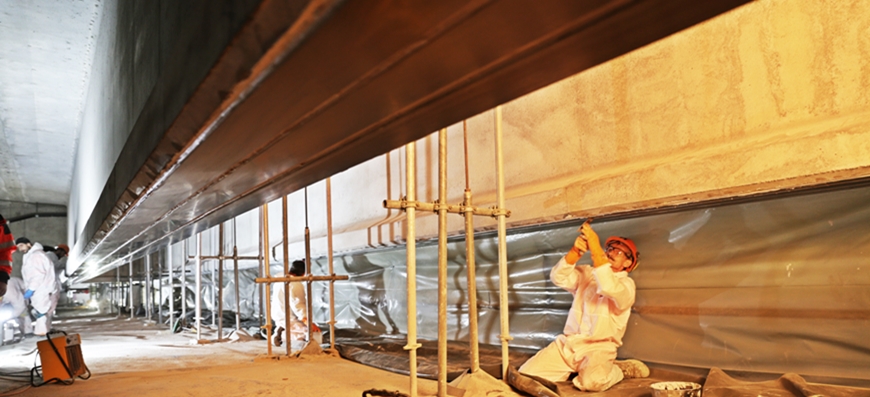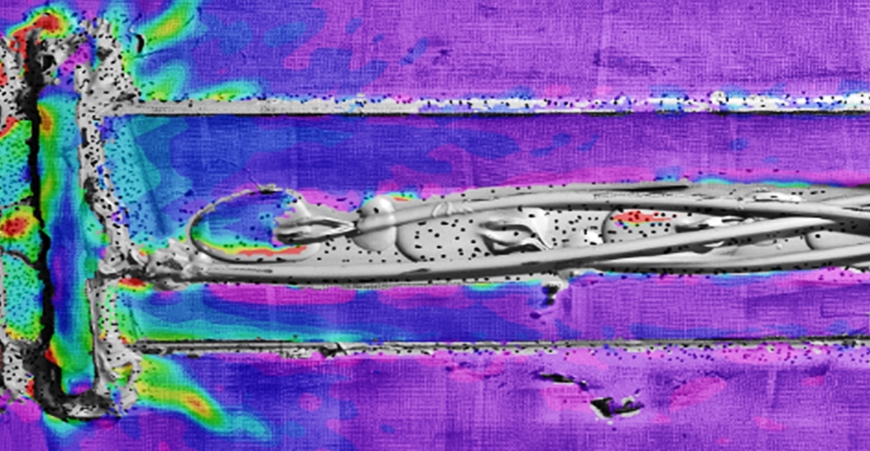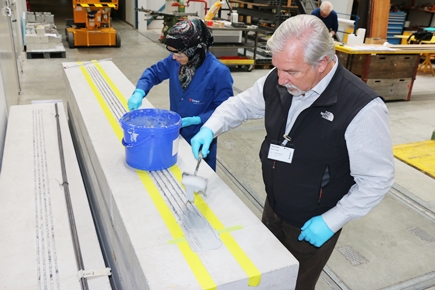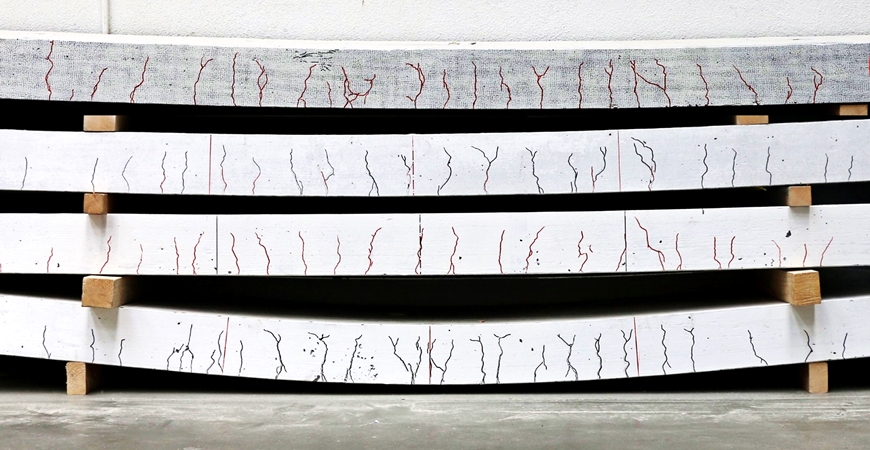Concrete
Prestressed plasters for old buildings
The technology of stabilizing concrete structures with carbon fiber-reinforced polymers, thus helping them to last longer, was developed decades ago; among others at Empa. Today, researchers in Dübendorf are working on a new variant with prestressed lamellas – with good prospects for practical application.

Bent concrete beams, cracks on the undersides of bridges, risk of rust for the reinforcement: In Switzerland, many structures are getting on in years. Take national roads, for example: According to the 2019 report of the Federal Roads Office (FEDRO), a large proportion of bridges were built between the mid-1960s to the 1980s – with significantly lower traffic loads than today.
Carbon fiber-reinforced polymers (CFRP) have long been used to refurbish supporting structures that are groaning under their loads: Flat lamellas, bonded to the underside, counteract the load. In the "Ebrog" method (for externally bonded reinforcement on grooves), for instance, which has only emerged in recent years, narrow grooves are milled longitudinally into the girder beforehand: an enlarged surface area for force transmission, which also acts deeper into the concrete. This method was used for the first time in 2018 for a bridge refurbishment in Küssnacht.
Now Empa researchers are developing the method further in an Innosuisse-funded project and in cooperation with S&P Clever Reinforcement Company in Seewen. The team led by Christoph Czaderski from Empa's Engineering Structures lab is testing prestressed CFRP laminates that "actively" reinforce concrete beams: They are bonded with epoxy resin under tensile stress. Once the bond has hardened, the ends are relaxed – and the strips, which "want" to contract, counteract the deflection even more.
Tricky in detail

What sounds simple at first is tricky in detail – especially at the strips' ends, where enormous tensile forces of up to 14 tons act. To prevent them from tearing off, they have to be fixed reliably. Until now, this has been done with aluminum plates, glued and secured with dowels – but the Empa team has designed U-shaped CFRP stirrups specifically for the new method. The advantages: a more precisely defined transmission of forces and, above all, a metal-free construction – immune to ubiquitous and dreaded corrosion.
"A solution made of a single material is always better than two that behave differently," explains Czaderski. "Especially for the anchoring, we perfomed a lot of tests in the lab." The team benefited from experience at the Isfahan University of Technology in Iran. "A lot of basic research was done there," Czaderski explains. "Our postdoctoral fellow Niloufar Moshiri came to us with the idea of combining the Ebrog process with prestressing."
The potential is great, as tests in the lab show: The process with prestressing and CFRP stirrups increased the load-bearing capacity of a concrete slab by 77 percent compared with the classic reinforcement method, i.e. without grooves and prestressing. Even without prestressing, the difference was still 34 percent.
Idea of an expert from Iran

In order to bring the technology to the market, large-scale tests on concrete slabs with a span of six meters are to provide further insights before a real refurbishment project will follow later in 2021. Meanwhile, the industry partner is already working on practical aspects. The experts are developing an industrial process for the U-shaped stirrups, which were previously formed by hand from carbon profiles. And the equipment, with which the lamellas have been prestressed up to now, "has to be redesigned for the new process," explains Martin Hüppi, who leads the project at S&P and has been cooperating with the Empa experts for a long time.
Efforts that could be worthwhile: Any structure that is refurbished rather than rebuilt saves not only costs but also CO2 emissions. In addition, the process would be easier and faster to handle during installation. "It would also be reasonably priced for building owners," says Hüppi, who sees good opportunities for numerous applications – not only for "rejuvenating" large-scale structures such as bridges, but also in residential renovations. "I absolutely see a market for this," says Hüppi, "and with prestressing, you're only really exploiting the full potential of the material."

Diagnostics
Early detection of dementia
Alzheimer's and other dementias are among the most widespread diseases today. Diagnosis is complex and can often only be established with certainty late in the course of the disease. A team of Empa researchers, together with clinical partners, is now developing a new diagnostic tool that can detect the first signs of neurodegenerative changes using a sensor belt.
>>>>

Gloss
RIP, Hypatia …
Hypatia, the joint cluster computer of Empa and Eawag, is no more. On 10 March, the well-behaved and fast helper for scientific simulations was dismantled in Empa's basement and loaded onto the trucks of a waste disposal company. Many components of the mainframe will now begin a new life elsewhere. Hypatia was named after one of the few female scientists of antiquity who lived in Egypt in the 4th century.
>>>>

Solid state physics
Filigree chemistry for mega crystals
An international team led by Empa and ETH Zurich researchers is playing with shape-engineered nanoscale building blocks that are up to 100-times larger than atoms and ions. And although these nano "Lego bricks" interact with each other with forces vastly different and much weaker than those holding atoms and ions together, they form crystals all by themselves, the structures of which resemble the ones of natural minerals. These new mega-crystals or superlattices that are depicted on the cover of the latest issue of "Nature" exhibit unique properties such as superfluorescence – and may well usher in a new era in materials science.
>>>>






